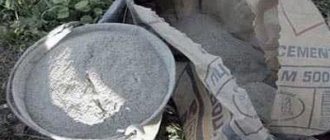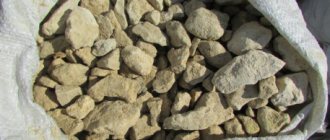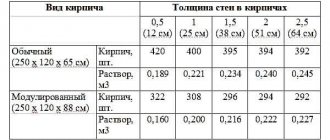The density of cement is one of the main characteristics of a building material. It is defined as the ratio of its mass to its occupied volume. There are many factors that influence the value of this parameter. Read to the end to learn all the nuances of determining the density of a material for preparing ideal building mixtures.
Portland cement - bulk mixture Source obyava.ua
Definition of concepts
Cement is a granular, fine-grained material. It is not a homogeneous mass. This substance is a mound of microscopic elements, between which there is air. Therefore, its density does not have a single meaning. To define this characteristic, two terms are used:
- true density;
- bulk density.
The specific gravity of cement is defined as the ratio of mass in kg to volume in cubic meters. m. Dividing these values gives the desired result. To obtain the first parameter, the mass is taken into account, which consists exclusively of grains of building material without air particles. True density is an indicator found in educational and methodological literature. When determining this parameter, it is assumed that the substance is monolithic.
Bulk density is more important to builders. It indicates the specific gravity, taking into account the air that is between the particles. Powdered substances always take up more space in space. Therefore, its true density will be significantly less.
Structure of cement under a microscope Source docplayer.ru
Bulk and specific
Any bulk substance, which includes cement, consists of solid particles separated by air voids. The volume of air surrounding each particle changes under the influence of external conditions, therefore the mass of the same amount of cement can be different.
For each bulk material, there are 2 physical parameters, which are defined as the ratio of its weight to the volume it occupies. They are called bulk and specific (true) density of the substance. When determining the first parameter, the volume of air accumulated between the particles of the material is taken into account.
It is used for construction calculations of the required amount of cement in a loosened state. The values for the bulk density of cement in kg/m3 (kilograms per cubic meter) for the most common grades are given in the table:
| Brand | M100 | M200 | M300 | M400 | M500 |
| Density | 700 | 900 | 1100 | 1200 | 1300 |
Specific density is a constant value. When calculating it, it is assumed that the particles of the substance adhere to each other so tightly that there is no air gap between them. The true density of cement is always higher than the bulk density and can reach 3200 kg/m³.
How do the properties of a material change in the external environment?
The density of Portland cement is not a static value. It changes depending on the conditions in which the material is located.
The position of particles is greatly influenced by static electricity. Upon contact, microscopic elements accumulate a charge of the same name. According to the laws of physics, such particles repel each other. As a result, the volume of material will increase slightly.
Therefore, freshly prepared cement powder has the lowest density. The same indicators apply to material that was recently shipped. During transportation, the bulk substance is compacted. Under the influence of vibration, microscopic particles occupy a position that implies maximum filling of voids. Bulk density also increases during long-term storage. Over time, static electricity “dissipates”, which leads to compaction of the mass.
Transportation of cement powder in bulk Source perevozka24.ru
See also: Catalog of companies that specialize in facade and finishing materials.
Characteristics of cement, its chemical formula
Cement is a substance with a multicomponent formula, which is made artificially from mineral raw materials. It belongs to materials of inorganic origin and has astringent properties.
It is used in construction for the preparation of cement mortars of various compositions. When dry cement is mixed with liquid, a dark gray plastic mass is formed that can evenly fill the mold of the desired configuration. The solution gradually hardens and takes on a stone-like appearance.
The formula of this material depends on its type. Thus, in Portland cements, calcium oxide predominates (up to 67%), silicon dioxide (up to 22%), aluminum oxide (up to 5%), magnesium oxide (no more than 5%), sulfur oxide (from 1.5 to 3. 5%), and sulfate resistance of the material is achieved by reducing the content of calcium aluminates.
The composition of pozzolanic substances, in addition to CaO and mineral additives, includes gypsum (calcium sulfate dihydrate). The basis of aluminous cement mixtures is low-basic calcium aluminates, and calcium oxide and aluminum dioxide are present in comparable quantities (50-55% and 45-50%). Slag cements are made from finely granulated blast furnace slag with or without the addition of limestone.
Due to differences in chemical composition, each type of mixture has its own physical and performance properties, which determines their use in different areas of construction.
First of all, experts pay attention to the following characteristics of cement:
- bulk density;
- specific (true) density;
- setting and hardening time;
- strength indicators;
- moisture and frost resistance;
- grinding fineness;
- corrosion resistance.
All indicators may vary to some extent depending on external conditions. The first 2 of them are decisive when calculating the amount of material required for the construction of any object.
How much does cement weigh?
The specific gravity of cement depends on many factors. On average, this figure is 1100-1600 kg/cubic meter. m. The density value is influenced by the following factors:
- Brand . The higher it is, the greater the specific gravity.
- Production technology. The method of making cement affects the size and shape of its constituent parts. Therefore, it is natural that it will have different physical properties.
- Composition of the building mixture . It may contain hydrophobic additives and various additives, which affect the physical characteristics.
- Compliance with storage conditions . Hermetic containers and optimal microclimate parameters in the room where the material is located ensure that it has the characteristics declared by the manufacturer for a long time.
- Date of manufacture . “Fresh” cement has a higher density than material that has been significantly compacted over a long period of time.
Proper storage Source 1nerudnyi.ru
Concrete density kg/m3 - table, classification, types
There are several classifications of concrete, the main one being the average density classification.
Based on this feature, there are 5 types of concrete:
- Particularly heavy. The density of such concrete is approximately 2500 kg/m3 or more. Steel scraps, magnetite, and iron ore are used as filler. This type includes steel concrete, barite and magnetite (their name directly depends on the main filler). Extra heavy concrete is used in the construction of special structures. For example, to protect against the effects of radiation, it is used in the construction of nuclear power plants.
- Heavy. They have a mass from 2000 to 2500 kg/m3 . Limestone, granite and other rocks, as well as dense sand, are used as filler. It is widely used in heavy industry - the construction of load-bearing supports of buildings and structures, foundations, buildings with increased background radiation.
- Lightweight. The density of such concrete is from 300 to 2000 kg/m3 . The main filler is crushed stone. It is classified as a type of ordinary concrete, widely used in the construction of residential buildings, foundations and walls. The main advantage of this type of concrete is its weight, which allows it to be used in various areas.
- Easy. Their average density is 500 – 1800 kg/m3 . Expanded clay, pumice, that is, mainly porous aggregates, are used as fillers. In turn, this type of concrete is divided into 2 types: • Structural thermal insulating concrete, the average density of which is from 500 to 1400 kg/m3 . • Structural concrete with a density from 1400 to 1800 kg/m3 . Such concrete is widely used in the construction of apartment buildings and shopping centers; its light weight allows it to be widely used in any type of civil construction. In areas with a high tendency to earthquakes, it is especially relevant.
- Particularly light. Concrete that has a density of less than 500 kg/m3 is called particularly light. The main filler is perlite or wood concrete, fairly light rocks. This type includes gas and foam concrete. They are mainly used in the construction of walls of residential buildings, when laying floors or creating additional thermal insulation conditions.
This classification of concrete by density makes it possible to take into account the average density, which means the aggregate of the concrete mixture, its porosity and average weight. Depending on the type of construction, area of application and purpose, a certain type of concrete is used.
Density value for different types of cement powder
The regulatory construction documentation indicates the following density indicators for different types of cement (true/bulk, kg/cub.m):
- pozzolanic – 2800/900;
- slag – 2900/1200;
- aluminous – 3100/1100;
- Portland cement – 3200/1200.
The bulk density of M500 cement is 1300 kg/cubic. m. This is a standard value for a reference material that does not contain additives and is stored under ideal conditions. The bulk density of cement M400 is 1200 kg/cubic. m. For material of the same brand, which is characterized by a long setting time, this figure is 1500 kg/cubic. m.
Indicators of different types of cement
For convenience, the possible values of the indicator for various brands are summarized in the table:
| No. | Name | Density (kg/m3) | |
| Bulk | True | ||
| 1 | Aluminous | 900–1150 | 3050–3100 |
| 2 | Sulfate-slag | 1050–1200 | 2850–2950 |
| 3 | Portland cement (without impurities) | 1150–1600 | 3150–3500 |
| 4 | Slag Portland cement | 1150–1250 | 2950–3050 |
| 5 | Pozzolanic Portland cement | 850–1150 | 2750–2950 |
| 6 | Sulfate-resistant pozzolanic Portland cement | 850–1100 | 2700–2850 |
When performing calculations in practice, averaged data are often used. At enterprises producing reinforced concrete products, standard calculations include a mass-to-volume ratio of 1300 kg/m3. This calculation is also used by private developers. This figure is realistic for freshly ground building materials of medium friability, packaged in paper bags.
Characteristics of cement
How to calculate the weight of cement for preparing building mixtures
When calculating the necessary ingredients for preparing concrete or mortar, novice builders have difficulties. The amount of mixture for work is determined in cubic meters, and cement is measured in kilograms. It is sold in bags in standard packaging of 25 and 50 kg.
Cheat sheet for preparing different grades of concrete Source cemmix.ru
To calculate how much a bag of cement weighs (more precisely, its volume), use the average density - 1300 kg / cubic meter. m. Therefore, 1 cubic. m of material weighs 1300 kg. A 25 kg bag has approximately a volume of 19 liters, a 50 kg bag has a volume of approximately 38 liters.
A bucket of cement (standard 12 liters) will weigh 15.6 kg. The mass of the material can also be determined experimentally. It is enough to weigh the mixture directly in the bucket, after subtracting the weight of the container. If the measured value differs greatly from the calculated value (15.6 kg), the quality of the material can be suspected. To determine its approximate density, the resulting weight must be divided by the container volume.
Calculation and determination
The specific density of dry cement in industrial conditions is determined by the Le Chatelier device. But to assess the strength of future concrete or other mortar, you need to know the value of the bulk density, because it determines how porous the structure will be. In construction calculations, average indicators are most often used. For fresh material, values of 1200-1300 kg/m³ are used, for compacted material - 1500-1600 kg/m³.
But sometimes, in order to mix a durable solution, it is necessary to know the exact value of this parameter. You can make the correct calculation of bulk density yourself.
To do this you will need:
- measuring container with a volume of 1 l;
- funnel;
- scales.
First, weigh the empty container. This mass is designated as M1. Then cement is carefully poured into the measuring cup through a funnel, the excess is removed and it is weighed again. In this case, the container with the contents is not shaken, the material must not be mixed or compacted.
The mass of the filled vessel is denoted as M2. The required value is determined by the formula: P = (M1 - M2)/V. The value of mass in calculations should be expressed in kilograms, volume - cubic meters.
To obtain the most correct data, measurements and calculations are carried out twice, and the final result is displayed as an arithmetic mean. Using this method of calculating bulk density gives results with an error of up to 0.01 kg/m³, which allows you to achieve the required strength of the structure being built and avoid significant errors during construction.
Rules for performing calculations
Calculating the bulk density of a material is quite simple. To do this, you do not need to use complex equipment and a specialized laboratory. To determine the necessary parameters, you will need the following devices:
- funnel , the hole in which is sufficient for the free passage of mixture particles;
- graduated cylinder - for measuring the volume of material;
- scales - to determine the mass of a bulk substance.
Calculating the volume of powder entering the bag
In fact, determining the binder content of one bag is more difficult than it might seem. First, it’s worth checking the mass of cement. Often the standard factory packaging for a bag of cement is 50 kg. There is also a bag for 25 kilograms and 40 kilograms. However, a bag weighing 50 kilograms may differ from a similar one in a number of related parameters:
- presence of additives;
- cement density level;
- as a consequence of the previous point, the space occupied in 1 bag.
It is worth considering the fact that the characteristics of the powder may change over time. In particular, the density value is lowest at the end of production (so-called bulk density) due to air saturation. When transportation occurs, the bulk density parameter increases. And even if the conditions under which storage is carried out are optimal, then within a year the initial number will increase by about 35%.
How is the calculation carried out?
The specific density level is the mass of 1 m3 of cement. For typical Portland cement, the average figure is 1300 kg/m3. If you use it, then the content in a 50-kilogram bag can be calculated using the following mathematical proportion:
1300 kg/m 3 – 100% 50 kg – X% X = 50*100/1300 = 3.85%
Accordingly, the share of 50 kg bag of cement from 1 cubic meter is 3.85% or 0.0385 cubic meter.
Tabular Data Set
In a bag weighing 25 or 50 kilograms, the values can be recalculated using the same simple formula. We have taken into account all numerical parameters in a number of tables.
| Type of powder | Specific gravity of cement per cubic meter | How many cubes are in a package | ||
| 25 kg | 40 kg | 50 kg | ||
| Portland cement | 1200-1300 | 0,019 | 0,031 | 0,0385 |
| Slag Portland cement | 1100-1250 | 0,02 | 0,032 | 0,04 |
| Sulfate-slag | 1000-1200 | 0,023 | 0,036 | 0,045 |
| Pozzolanic | 850-1150 | 0,025 | 0,04 | 0,05 |
| Sulfate resistant | 800-1100 | 0,026 | 0,042 | 0,053 |
If you want to get a cube of concrete, but only have packaged powder, you use buckets (standard for 10 liters).
| Composition brand | Mass indicator for 10 l of mixture (kg) | |
| M400 | M500 | |
| M100 | 78 | 90 |
| M150 | 64 | 73 |
| M200 | 54 | 62 |
| M250 | 43 | 50 |
| M300 | 41 | 47 |
| M400 | 31 | 36 |
| M450 | 29 | 32 |
However, it is preferable to know how many bags of cement will be needed to create a cubic meter of concrete solution.
| Brand identity of the composition that will be obtained | Brand name of binder powder | Mass value in cubic meter of the mixed composition | Number of fifty-kilogram bags of cement) |
| M150 | M300 | 260 | 5,2 |
| M200 | M300 | 290 | 5,8 |
| M400 | 250 | 5 | |
| M500 | 220 | 5,4 | |
| M250 | M300 | 340 | 6,8 |
| M400 | 300 | 6 | |
| M500 | 250 | 5 | |
| M300 | M400 | 350 | 7 |
| M500 | 300 | 6 | |
| M400 | M400 | 400 | 8 |
| M500 | 330 | 6,6 |
Knowing the weight of the bag, as well as easily determining the weight of cement in 1 m3 of powder, you can ensure less consumption for the controlled object. Calculate the volumetric weight using the proposed formulas, and get useful tips from other articles on our site. For example, we will tell you how to compare the number of kilograms in relation to other components of the composition, for example, with sand or a number of solid particles such as crushed stone. We describe everything you need to know to pour a foundation or bring out the best in a cement composition.
Briefly about the main thing
Experts distinguish true and bulk densities of cement, which differ significantly from each other. Also, this indicator is influenced by many factors - mixture composition, duration and quality of storage, production technology, strength brand.
Determining the specific gravity of cement powder is quite simple at home. For this you will need a scale and a measuring cylinder. Also, the approximate density of the material can be determined directly at the construction site by weighing a bucket filled with cement.
bauxite cement ratio
Types of properties of cement Cement production Cement marking Universal Formula for calculating the number of cubes of cement in a bag
Cement is divided into several groups according to the presence of minerals: Portland cement - clinker predominates with a percentage of 50 to 70, and contains tricalcium silicate. It is the most popular type in construction due to its high strength and speed of hardening; Aluminous cement is crushed clinker, which contains bauxite and limestone. The presence of monocalcium aluminate in the substance determines the speed of
How is it determined?
It's not that difficult. To work, you will need a container of known volume (the easiest way is to use 1 liter) and a funnel. The order of determination is as follows:
- The container is weighed;
- Through a funnel, cement is poured into a container;
- Excess material is removed;
- The container is weighed when filled;
- The mass of the empty container is subtracted from the result;
- The resulting net weight of the powder in kilograms is divided by the volume in cubic meters (a liter is 0.001).
Production
Cement binder is a product of clinker grinding with a standardized composition. The characteristics of raw materials are determined by GOST 10178-85. According to the document, the content of magnesium oxide should not exceed 5% (in some cases - 6%), and the amount of other components is determined by the type of binder and its purpose.
The raw materials for production are natural minerals (alite, alumina, magnesite, gypsum); each has its own compliance regulations. Clinker is produced from raw materials by firing.
The main component can be combined with mineral additives that affect the individual properties of the working solution and the finished stone. The number of the latter also determines the standard (Table 1):
Various additives can be added to the composition of M400 cement to improve the plasticity of the solution, the frost resistance of concrete, and the resistance of the structure to aggressive influences. Their total amount should not exceed 5% by weight of the binder component.
Clinker with the calculated amount of additives is crushed in drums up to 92%.
Features of cement consumption M-500
The consumption of M500 cement when preparing concrete depends on the purpose of preparation:
- for the construction of floors and foundations, the ratio of cement and sand is 1:2;
- to create masonry mixtures, the proportion is 1:4;
- for plastering work, creating floor screeds, garden paths - 1:5.
M500 cement is more economical than M400 and cheaper grades: as the grade increases, the amount of substance required to form a volumetric unit of concrete or ready-made mortar decreases.
Cooperation with AlfaCem
With the group, it will become easier not only to learn about the correct preparation of compounds and how they are used to achieve optimal strength. We are ready to deliver dry powder building materials throughout Moscow and the Moscow region. All products comply with GOST and have an accompanying certificate issued in accordance with technical standards.
Leave a request or call us directly (section “Contacts”) to discuss the details of the order. A competent manager will draw up an adequate estimate, taking into account the optimal ratio of building materials. You don’t have to independently determine how much a bag of cement actually weighs. It is enough to select its type, having previously described the factors that potentially influence the future construction.
By minimizing consumption, you will save significantly, because we offer extremely competitive prices. The cost may become even lower due to discounts and bonuses. We will be grateful to every client who writes positive reviews about the company or brings constructive criticism to us. This helps to significantly improve service. Waiting for you!
© Online store of building materials "AlfaCem" 2001–2021
Source
The process of preparing the required solution
Sand-cement mixtures are used for masonry or plastering work. The requirements for the components vary. At the first stage, pour water, then lime and mix until a homogeneous white liquid is formed.
For finishing, only fine-grained clean sand is used. It is recommended to prepare the solution in a large container. On the second, sand is added. Clean from foreign impurities: grass, leaves, stones and other foreign bodies.
If you purchase a ready-made mixture, you must follow the instructions on the package. Add plasticizers if necessary.
Calculation of volumetric weight
To calculate the specific gravity of cement in 1 m3, use
The indicator is measured in kg/m³. To convert kg to tons, you need to divide the resulting value by 1000.
Brand of solution
The volumetric mass of the solution varies depending on the brand used and
- from M100 to M200 - 900;
- from M300 to M500 - 1100;
- sand-cement mixture - 1700;
- cement-perlite and slag compositions - 1000-1400.
Areas of use of brands
During construction, it is important to maintain the compatibility of materials. If the facility uses bricks of grade 100, then the cement mortar for connecting them should be M100. For plastering, leveling walls, and interior finishing work in dry rooms, cement grades M200 and M300 are used.











